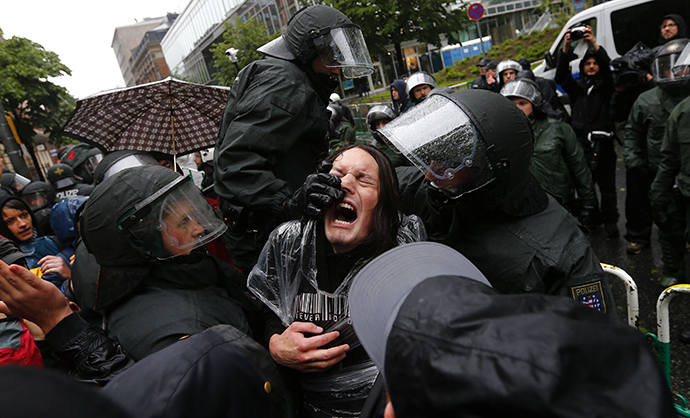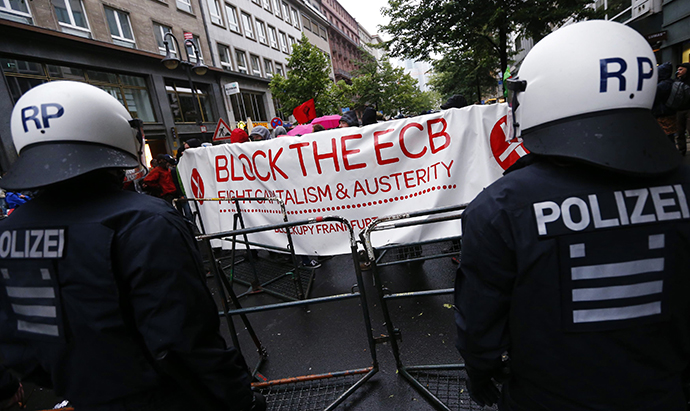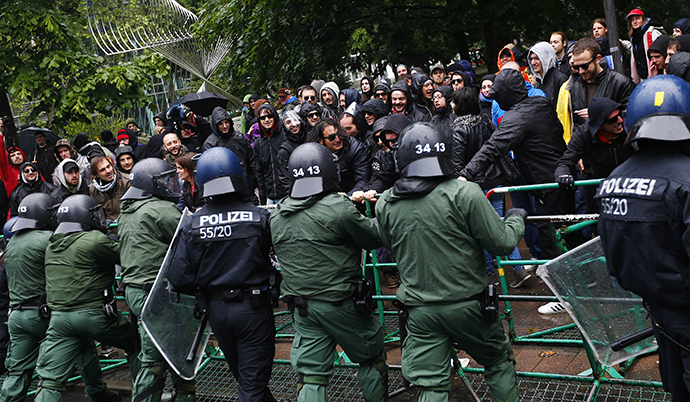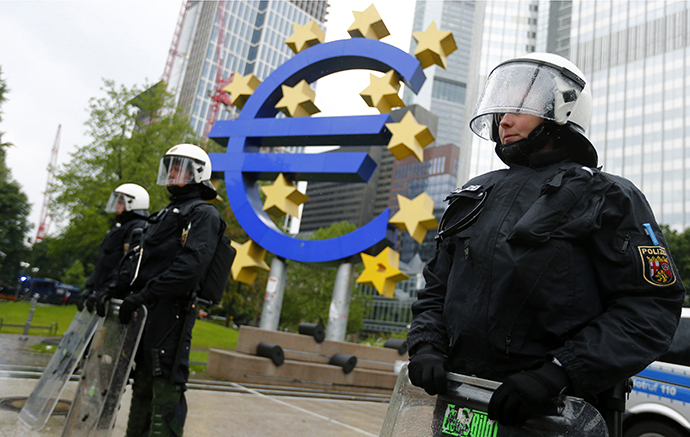 Students
from Ferebee-Hope Elementary School in Washington, DC rally in front of
the courthouse May 10 to save their school from closure. (Photo: Rania
Khalek)
Truthout
is able to confront the forces of greed and regression only because we
don’t take corporate funding. Support us in this fight: make a
tax-deductible donation today by clicking here.
The District of Columbia's planned public school closings
disproportionately affect minority and special needs students and there
is no evidence the plan will improve educational outcomes or save the
district money.
Students
from Ferebee-Hope Elementary School in Washington, DC rally in front of
the courthouse May 10 to save their school from closure. (Photo: Rania
Khalek)
Truthout
is able to confront the forces of greed and regression only because we
don’t take corporate funding. Support us in this fight: make a
tax-deductible donation today by clicking here.
The District of Columbia's planned public school closings
disproportionately affect minority and special needs students and there
is no evidence the plan will improve educational outcomes or save the
district money.
"I don't want my school to close because they have a lot of fun
things that I like there," said 9-year-old McKea, a third-grader at
Ferebee-Hope Elementary School in Washington, DC. "If they take that
away, I won't have nothing else fun to play with or do.”
Dressed in their Ferebee-Hope cheerleading uniforms, McKea and her
teammates were accompanied by Shannon Smith, who has two grandchildren
at Ferebee-Hope, one of 15 schools
slated for closure
by DC School Chancellor Kaya Henderson. Smith led the children to a
rally outside the E. Barrett Prettyman Federal Courthouse, where several
DC parents, students and activists had gathered to support a lawsuit
against the closings.
It turns out that all 15 schools are located east of Rock Creek Park,
an unofficial dividing line between poor minority communities on the
east side and affluent white neighborhoods west of the park, leading to
allegations that school closings are an attempt to privatize public
education at the expense of the city's most vulnerable residents.
"They keep taking things away from our kids and expect our kids to
achieve," Smith told Truthout. "This is discrimination against our black
kids.”
Suit Charges Closings Target Vulnerable
Empower DC, a grassroots organization at the forefront of the
movement to halt the closings, has teamed up with civil rights attorney
Johnny Barnes to sue the district for discrimination on behalf of Smith
and four other plaintiffs. The lawsuit accuses Mayor Vincent Gray,
Chancellor Kaya Henderson and the district of violating local and
federal civil rights laws by disproportionately targeting poor, minority
and disabled students with their school closure plan. And they have
some shocking numbers to back their claims.
Of the 2,700 students who will be impacted by the closings, just two
(less than 0.01 percent) are white, even though white students account
for 9 percent of the overall District of Columbia public school (DCPS)
student population, according to calculations made by
district budget expert Mary Levy.
In stark contrast, African Americans make up 93 percent of those
affected despite comprising just 72 percent of the district's student
body. This disparity is mirrored in the economic realm, where poor
children account for 96 percent of students impacted by closures, though
they make up 77 percent of DCPS students. And despite being just 14
percent of the DCPS population, special education students make up 29
percent of those affected by the closings. To make matters worse,
one-third of students who will be displaced by the closings experienced
school closures in 2008, when then-DCPS Chancellor Michelle Rhee closed
some two dozen schools in mostly low-income neighborhoods of color.
University of the District of Columbia social sciences professor Amanda Huron created a map to highlight these disparities.

Attorney Barnes recently filed for a preliminary injunction to halt
the closure plan until the lawsuit is resolved, but the request was
denied by US District Judge James Boasberg in mid-May.
Though Boasberg conceded that the closures will disproportionately affect minority and disabled students, but
he ruled,
"There is no evidence whatsoever of any intent to discriminate on the
part of defendants, who are actually transferring children out of
weaker, more segregated, and under-enrolled schools" and into "better
performing, more integrated schools."
Boasberg’s claim is contradicted by calculations made by DCPS budget expert Mary Levy. Using the district’s own data,
Levy found:
“Of 11 closing schools, students at nine will attend schools that are
almost 100 percent African-American. At the remaining schools, some
black students will encounter more Latinos, some fewer. None of the
receiving schools has a noticeable number of white students.”
Furthermore, “Virtually all the proficiency levels at receiving
schools are below the DCPS average for their level, which is itself
below 50 percent,” Levy found.
DCPS Chancellor Henderson and DC Attorney General Irvin Nathan applauded Judge Boasberg's
decision, which trumpeted many of the
claims made in Henderson's Consolidation and Reorganization Plan.
Under-Enrollment Self-Inflicted
City leaders have said that school closings are necessary because of a
decline in student enrollment, which has left behind under-utilized
school buildings that are too costly to maintain. But a closer look at
the data reveals that "under-enrollment" is largely self-inflicted.
Following 23 school closings in 2008 under then-Chancellor Rhee, DCPS
lost 4,299 students, while charter school enrollment increased by
3,957. What officials are labeling a "decline" in enrollment is actually
a "shift" from public to charter schools.
Thus, DCPS has created an endless cycle whereby it cites
under-enrollment and low test scores to justify closing schools, causing
displaced children to flee to charters, creating a further decline in
public school enrollment, which is used to justify another round of
closings.
When Michelle Rhee was appointed school chancellor in 2007, charter
schools enrolled 30 percent of DC public school students. Today, that
number has jumped to 43 percent.
"The schools are under-enrolled because they've been replaced by
charter schools in the same areas," says Trayon White, state Board of
Education representative for Ward 8. "It's by design.”
Indeed, the system is designed to give charter schools first dibs on
closed public school buildings, thanks to the District of Columbia
School
Reform Act of 1995, essentially guaranteeing charter school expansion in the aftermath of mass school closings.
To speed the process along, Mayor Vincent C. Gray recently announced
that 16 public school buildings will be leased to charter school
companies this year, including eight of the 15 schools slated for
closure. This follows a nationwide trend that has seen more than 40
percent of closed public school buildings across the country turned over
to
charter schools.
Meanwhile, charter schools have not been subject to closure, even
though three-quarters of them qualify as "under-enrolled" by the
district's
own criteria.
White expressed bewilderment at the school system's obsession with
school enrollment thresholds. "I'm not in favor of under-enrolled
schools; I'm in favor of smaller class sizes," said White. "The emphasis
should be put on the student-teacher ratio, not how many kids are in a
building."
White also highlighted that school closings do not save money. In fact, closings do just the opposite.
According to a
report
by the DC auditor's office, Michelle Rhee's decision to close 23
schools in 2008 ended up costing the city around $40 million, four times
what DCPS estimated. The Washington Post
summarized the findings:
The original $9.7 million price tag should have also included another
$8 million that the city spent to move to demolish buildings, remove
furnishings and transport displaced students, DC Auditor Yolanda Branche
wrote in a recent report. In
addition, Branche wrote, the city forfeited $22 million in lost
property value at the closed sites, bringing the total cost to about $40
million.
Chancellor Henderson has insisted that this time around will be
different, though she has yet to offer any specifics other than vague
cost and saving estimates that she said will result in
a net savings of $8.5 million.
Students With Disabilities
Two of the 15 schools slated for closure serve children with severe mental and physical disabilities: Sharpe Health
School in Ward 4 and Mamie D. Lee
School in Ward 5. Both student bodies are made up almost entirely of black students who qualify for reduced price and free lunch.
The district plans to merge Sharpe Health and Mamie D. Lee into one
school by fall 2014, at which time River Terrace Elementary School,
which was closed last spring due to under-enrollment despite impassioned
pleas from the community, will serve as the new school building for
Sharpe and Lee. Henderson wants to transform River Terrace into a
state-of-the-art learning facility geared toward students with
significant disabilities, a move that requires a top-to-bottom
renovation of the building.
Two of Andree Harris's six children attend Sharpe Health. Harris's
16-year-old son suffers from Triplegia (paralysis of three limbs) and a
traumatic brain injury, and her 4-year-old daughter is developmentally
delayed and does not know how to communicate, so instead, she "screams
and hollers."
"Sharpe has turned her whole life around," said Harris. "She's more
communicative. She claps her hands. She plays and interacts a whole lot.
That was not the case for her when she first got there." Harris has no
doubt that putting her daughter in an entirely different environment
will disrupt her progress.
According to Henderson's
proposal,
merging the schools will "allow students to attend school at a location
closer to their homes," though it's unclear how this is possible, given
that River Terraces is located in Ward 7, far from Sharpe and Lee.
The proposal also suggests that consolidation will ensure a more
efficient use of resources because both schools have fewer than 100
students enrolled. But the proposal fails to take into account the cost
of renovating River Terrace versus revamping Sharpe and Lee, which are
already equipped for students with disabilities.
The district has also failed to consider transportation difficulties.
Arthur Williams, a school bus driver who transports Sharpe Health
students, is deeply concerned about the impact of school closings on his
special needs students. "I'll be taking them to a school that will be
unsuitable. It will be more complicated to get them out and get them in.
And if something should happen to them, to get them to the hospital,
they got a longer distance to go," Williams said.
"[Sharpe Heath] was designed and built for kids who have
wheelchairs and special needs. Now you gonna put them in a school that
has two floors. You gonna move them all the way over to Northeast River
Terrace, near the Pepco plant with the pollution. You gonna move them
away from the proximity of the hospitals."
A Transportation Nightmare
The Broader, Bolder Approach to Education - a campaign launched by the nonpartisan Economic Policy Institute -
released a report in April that found no evidentiary basis for "market-oriented education" in Chicago, New York City and Washington, DC.
The report specifically analyzed the impact of school closures,
finding that they did more harm than good, most notably in the nation's
capitol.
The report's authors fear that this latest round of DC closures will
produce even worse outcomes by creating a transportation nightmare.
In 2008, closed schools were typically within walking distance from
their receiving schools. But so many schools have been shuttered since
then that the receiving schools this time around are too far away for
walking. And since DCPS only provides school buses for special education
students, the latest closures will force children to use the city's
costly public transportation system, which was designed to get workers
downtown, not children to school.
"The combination of distance and cost impedes attendance,
particularly for secondary students, who have farther to travel, and
teachers report that students sometimes fail to attend for lack of bus
fare. For those already disengaged, the added barriers may tip the
scales toward dropping out altogether," the authors argue.
Students at closed schools will also be forced to travel across busy
highways, intersections, bridges and tunnels, which can be dangerous
even for adults to cross.
Students at the soon-to-be-closed Kenilworth Elementary
School,
located in one of DC's poorest neighborhoods, will have to travel more
than a mile and cross an interstate highway to get to Houston Elementary
after their school is
closed.
It was Obama's Idea
Community groups at the forefront of the school closure issue are well aware [
] of the role President Obama has played in
pushing for school closings in urban areas.
In 2009, just six months into his first term, Obama announced his
administration's desire to see 5,000 failing schools closed and "turned
around" over the next five years, a policy that would become the
hallmark of his Race To The Top (RTTT)
agenda.
RTTT requires that school districts with low-performing schools
implement one of four "school improvement methods" - Turnaround,
Transformation, Restart and Closure - to receive federal grant money.
Turnaround and Transformation involve firing key members of the staff;
Restart requires turning over the school to a charter operator; and
Closure means shutting failing schools and sending their students to
higher-achieving schools.
As a result, Obama's education policies have further incentivized the
dismantling of public education that began with No Child Left Behind
(NCLB) under President George W. Bush, which has led Diane Ravitch to
conclude that "The Obama-Duncan
plan might as well be called 'NCLB 2.0.' "
Where is the Teachers Union?
The Washington Teachers Union has been largely silent on the issue of
school closings, and Truthout's repeated requests for comment from the
WTU were unsuccessful. The union's deputy chief of staff, Nadine Evans,
told Truthout that WTU bylaws allow only the president, Nathan Saunders,
to speak on its behalf and that the president was unable to be reached
because he was out of town.
But former WTU Vice President Candi Peterson told Truthout that the WTU bylaws contain no such requirement.
Peterson, a vocal critic of school privatization, was summarily
dismissed by Saunders in 2011 in what she believes was an effort to
silence her dissent.
"I've been very critical of the former and current chancellor, and
[Saunders] wanted me to stop," says Peterson, who blogs about school
reform at the Washington Teacher. She suspects that Saunders directed
his staff to turn away reporters on contentious issues like school
closings to avoid upsetting the chancellor and mayor.
Peterson is currently a social worker at Cardozo High, one of two
DCPS schools that Chancellor Henderson recently decided to
"reconstitute," which involves firing and replacing
the entire staff.
"This climate is so punitive that [teachers] are literally afraid to
speak out, to write, to use their real names," says Peterson, who added
that the WTU has "become a country club" due to the lack of strong
leadership.
That's why Peterson is running once again for WTU vice president, but
this time her running mate and presidential candidate is Elizabeth
"Liz" Davis, who has been a DCPS teacher for 35 years.
Davis teaches IT essentials at Phelps Architecture, Construction, and
Engineering, a relatively new high school in Ward 5, and, like
Peterson, is a vocal critic of the school reform agenda.
"[Former Chancellor Michelle] Rhee cultivated a climate of fear,"
Davis told Truthout, adding that the repressive climate has continued
under Chancellor Henderson, whom she described as "Michelle Rhee's
protege."
"You have people leading the school system that don't know a damn
thing about children," argued Davis, whose activism has gotten her into
trouble with DCPS several times throughout her career. She said she has
been involuntarily transferred seven times as punishment for her
activism, and she is currently under scrutiny for having organized the
parents to fight to keep the principal last year.
Davis was transferred to Phelps by Michelle Rhee, following a school
consolidation nightmare in 2008. Back then, Davis worked at Hart Middle
School, which merged with a rival middle school under Rhee, despite
warnings from the parents, students and even police that the merger
would ignite violence.
"After about 3 months, the school went up in smoke," Davis said.
"Things were out of control. Students literally took over the school one
day and hosed it down with fire extinguishers on all three floors.
Hazmat had to come in." Rhee's response was to fire the inexperienced
principal, whom she had handpicked against the judgment of Davis and
other teachers.
The consolidation of the two middle schools sparked so much violence, that then-DC Chancellor Michelle Rhee was forced
to send extra security and administrators to neutralize the tension.
While DCPS insists this time around will be different, the district
has yet to reveal a safety plan to assist schools with the transition,
though Henderson did remove Johnson Middle School from the school
closure list after recognizing that the dispersal of students to two
rival middle schools would likely result in violence.
Intentional Disenfranchisement
Henderson originally proposed closing 20 schools, but later removed
five schools from the list, including Ward 2's Garrison Elementary and
Francis-Stevens Education Campus, located in the city's whiter and more
affluent Northwest. She was persuaded to keep the schools open by the
mobilization of parents who presented her with detailed alternatives and engaged in recruiting efforts to increase student enrollment.
While Davis expressed support for the community's efforts, she
pointed out that parents in more impoverished wards are unable to mount
similar campaigns because they are purposely disenfranchised. Seven of
the nine DC schools Davis has worked at were located in Wards 7 and 8,
which contain the highest population of underserved minority students.
"I've learned from observing and working with principals in those
schools that everything is done to disengage and disenfranchise parents.
I literally had to start a war just to set up a PTA," said Davis. "I
find that parents of poor minority children are disengaged as part of a
systemic process."
Mayoral Control
It wasn't until 2007 - when the DC City Council voted to dissolve the
elected school board and transfer control of DCPS to then-Mayor Adrian
Fenty in a system known as
Mayoral control
- that Michelle Rhee was appointed DC school chancellor and allowed to
enforce draconian school reforms, which accelerated the replacement of
public schools with charter schools.
Mayoral control is often touted as preferable for districts with underperforming schools, however there is
no evidence
to suggest that mayors are superior to democratically elected school
boards. But without mayoral control over public schools, decision makers
in DC, Chicago, Philadelphia and New York City would never be allowed
to enact the overwhelmingly unpopular education reforms that have come
to the 21st century education landscape.
"The city has failed to evaluate mayoral control, despite enacting legislation calling for annual review," says the group
Empower DC.
The organization is calling for a moratorium on school closures to
allow time for these school reform policies to be properly evaluated.
Meanwhile, the trials and tribulations of school closings in
Washington, DC, highlight the need for an authoritarian power structure
to enforce what the public would otherwise never allow: the
privatization of public education.








 Faced with continued investor skepticism over its long-term business model,
Faced with continued investor skepticism over its long-term business model, 








